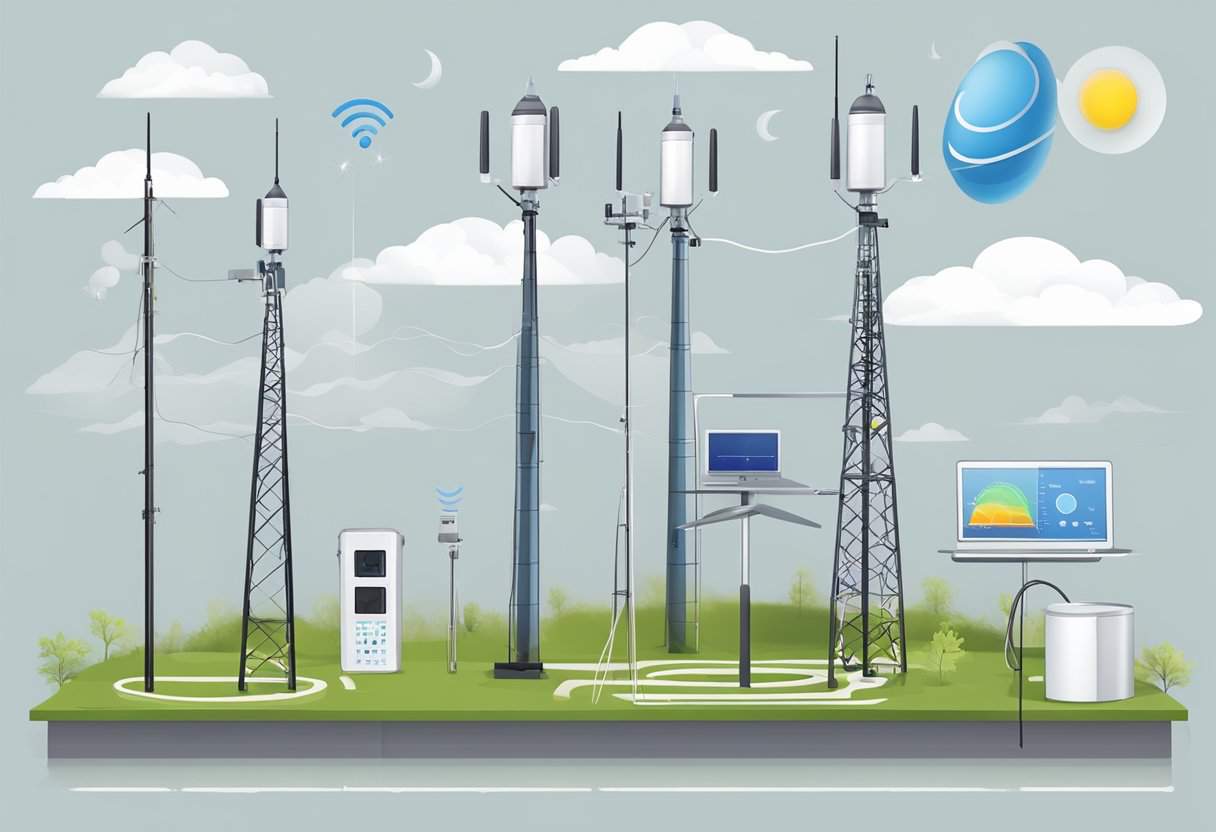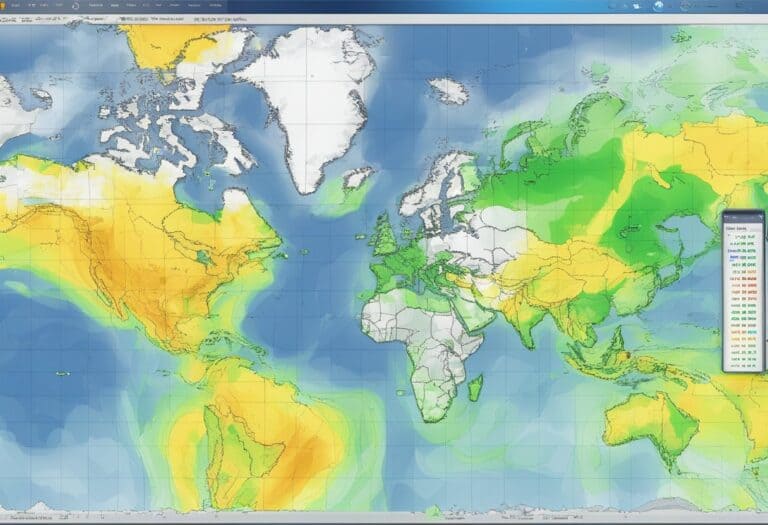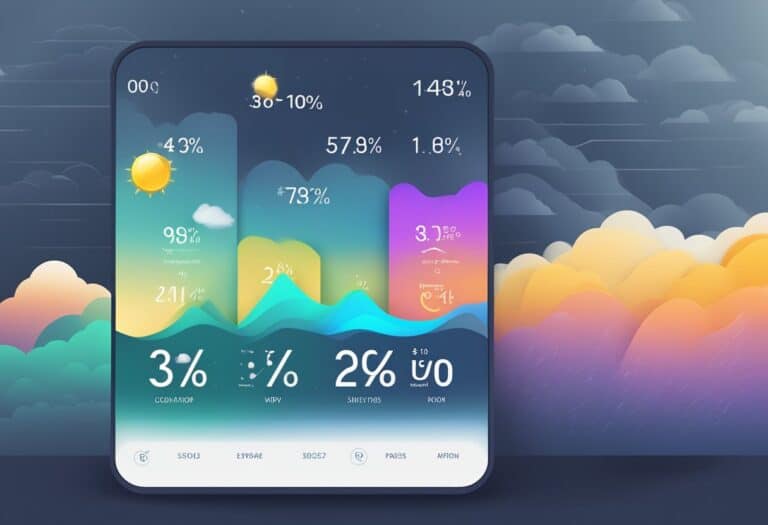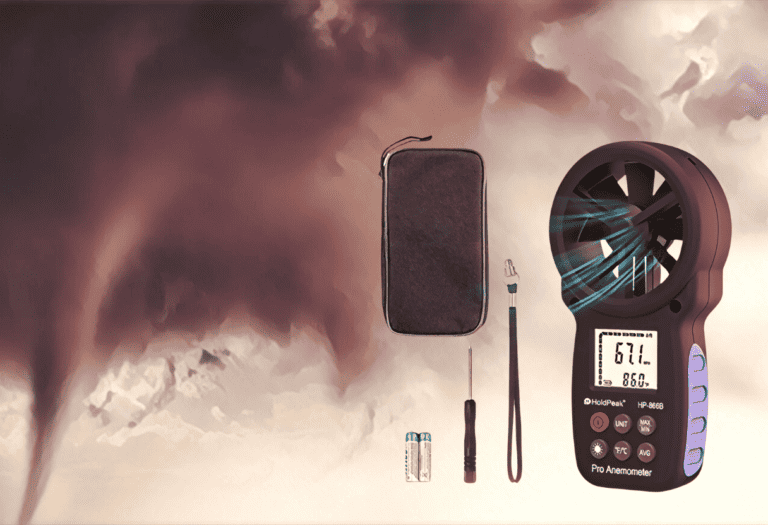Wireless weather stations revolutionize how we collect meteorological data, providing real-time information with minimal human intervention.
Unlike traditional weather stations that rely on direct physical connections, wireless weather stations use sensors to monitor environmental conditions such as temperature, humidity, wind speed, and rainfall. They transmit the collected data over wireless networks to a central display, making it accessible even from remote locations. This leads to a comprehensive understanding of weather patterns and, consequently, better preparedness for weather-related events.
The core of a wireless weather station’s efficiency lies in its array of sensors. Each sensor specializes in measuring a particular aspect of the weather, thus providing a multi-faceted insight into the environmental conditions of a particular area. Wireless connectivity eliminates the need for cumbersome wiring, facilitating easy installation and setup. Furthermore, these stations are designed to be low-maintenance and can operate autonomously, often powered by renewable energy sources like solar panels.
The ease of access to weather data, improved by wireless technologies, ensures that users from avid gardeners to professional meteorologists can make informed decisions based on the latest climatic information.
Wireless weather stations utilize sensors to measure atmospheric conditions like temperature and humidity, transmitting data wirelessly for real-time monitoring, thus enhancing decision-making for various applications from gardening to meteorology.
Understanding Weather Stations
Wireless weather stations are innovative devices that allow you to receive timely and precise meteorological data. Whether it is for personal or professional use, understanding how they function is pivotal for selecting the right type for your needs.
Types and Differences
Weather Stations: Generally, there are two main types of weather stations: wireless weather stations and wired weather stations. The key difference between these lies in how they transmit data. Wireless weather stations provide the convenience of placing sensors without the concern for wiring, as they use radio frequency to send data. Wired weather stations, on the other hand, require a physical connection, which can limit sensor placement but often offers more stability in data transmission.
- Home Weather Station: Typically, a wireless type that is compact, easy to install, and suitable for domestic purposes. It provides you with localized weather data such as temperature, humidity, and rainfall, directly to your personal device.
Differences:
- Data Transmission: Wireless weather stations send data over radio frequency, while wired stations use cables.
- Installation: Wireless systems are easier to install, with no need for complex wiring.
- Sensor Placement: Wireless stations offer more flexibility in sensor placement due to their lack of physical cables.
- Reliability: Wired weather stations might offer more reliability in data transmission, especially in areas with high interference.
By considering these factors, you can choose a weather station that best fits your need for meteorological data collection.
Components and Sensors

Wireless weather stations utilize a variety of sensors to provide you with comprehensive environmental data. Each of these sensors is specifically designed to detect and measure a particular atmospheric characteristic.
Temperature Measurement
Your wireless weather station determines temperature using a thermometer sensor, often a thermistor or a digital temperature sensor. Located in a shielded position, it accurately measures the ambient air temperature, which is then transmitted wirelessly to a display console.
Humidity Detection
A hygrometer sensor is responsible for humidity detection, measuring the moisture content in the air. These sensors provide you with a percentage reading, indicating the humidity level, which can help in predicting weather conditions and ensuring your personal comfort.
Wind Speed and Direction
To measure wind speed and direction, your station employs an anemometer. The device typically has rotating cups that capture the wind; the number of rotations per unit time correlates to the wind speed. A separate vane aligns with the wind flow to determine direction.
Rainfall Monitoring
Rain gauge sensors collect and measure the amount of precipitation over a given period. These gauges usually have a funnel that directs rainwater to a measuring mechanism, which quantifies the rainfall often reported in inches or millimeters.
Barometric Pressure Reading
Barometric pressure, vital for weather predictions, is recorded using a barometer within the weather station. The readings, provided in units such as millibars or inches of mercury, indicate rising or falling pressure trends that can alert you to changing weather patterns.
Additional Sensors
Some advanced weather stations may include additional sensors for more comprehensive data. These may measure factors like UV radiation, soil moisture, and leaf wetness, which can be particularly beneficial for gardening or agricultural applications.
Signal Transmission
In the realm of wireless weather stations, signal transmission is a crucial component that ensures the seamless flow of data from the sensors to the display console in your home. This technology makes it easier for you to collect and monitor environmental readings without the need for physical wiring.
Wireless Communication
Your weather station operates by utilizing radio waves to transmit information. Sensors placed in various locations gather atmospheric data, which is then sent wirelessly over a frequency typically in the 433 MHz range. This method allows for a robust, low-interference transmission, ensuring that the data you receive is as accurate and timely as possible. For example, some stations integrate into the Internet of Things, enhancing their ability to communicate over networks.
Data Collection and Transfer
Each sensor dedicated to collecting weather data has a specific role, measuring parameters like temperature, humidity, or wind speed. Once collected, this reading is instantaneously converted into a digital signal. This signal is then wirelessly transmitted, often leveraging a network such as GSM for data transfer, ensuring uninterrupted delivery from the sensor to your station’s display or even to a remote server or cloud service, facilitating real-time access to weather conditions. The design of weather stations often emphasizes the importance of efficient and reliable data transfer.
Powering Weather Stations
To ensure accurate and continuous weather data collection, it’s essential for your weather station to have a reliable power source. Power supplies in wireless weather stations are designed for longevity and minimal maintenance, typically involving batteries or solar power.
Battery Use
Your weather station may use batteries as a primary power source, providing consistent electricity to measure and transmit data. The longevity of these batteries depends on the station’s power efficiency and the battery capacity. You should expect to replace or recharge them periodically, which varies from months to years, based on usage and weather station design.
Maintenance Tip: Regularly check the battery levels to prevent unexpected power loss, which can lead to data gaps in your weather monitoring.
Solar Power
Many modern weather stations incorporate solar panels as a sustainable power source, either supplementing batteries or serving as the primary power supply. These panels capture solar energy to power the station and often charge backup batteries for nighttime or during low-light conditions.
Installation Note: Ensure optimal placement of your solar panel where it receives maximum sunlight, and clean the surface regularly for unobstructed energy absorption.
By understanding the power mechanisms of your wireless weather station, you can effectively monitor its performance and maintain its power supply for uninterrupted operations.
Data Display and Accessibility
Understanding how you can view and interact with the collected weather data is a key aspect of wireless weather stations. These systems offer several methods to access and display this information through both physical consoles and digital platforms.
Display Consoles
Your wireless weather station typically comes with a display console that shows the various environmental parameters it measures. These consoles have a digital display that enables you to monitor current conditions at a glance without needing any additional devices. Many consoles include features such as large, easily-readable numbers, graphs for historical data, and customizable alerts for certain weather thresholds.
Remote Access
For accessing your weather data remotely, your wireless weather station can connect to Wi-Fi or another type of internet connection. This connectivity allows you to view data on a variety of devices, such as a smartphone or a computer. Some systems integrate with platforms like Weather Underground, which aggregates data from personal weather stations around the world, giving you the ability to compare your local readings with wider meteorological trends.
Analytics and Forecasting
With the advent of advanced technologies in wireless weather stations, you can now obtain more effective analytics and forecasting capabilities. These systems allow you to gather data and predict weather patterns with enhanced accuracy, making it possible to anticipate weather changes with more confidence.
Weather Data Analysis
Wireless weather stations operate by collecting various meteorological data points such as temperature, humidity, wind speed, and atmospheric pressure. Your ability to analyze this data is critical for understanding current weather conditions. Data from sensors is transmitted wirelessly and stored for real-time and historical analysis. In some cases, as described in an approach using raspberry Pi 3 model B+, the system can even enable more nuanced insights into weather dynamics.
Predicting Weather Patterns
The ultimate goal of weather forecasting is to predict future weather patterns. By applying machine learning algorithms to the analyzed data, it is possible to forecast imminent weather events with a considerable degree of certainty. For example, using a machine learning perspective for data analytics in IoT significantly improves the load forecasting capabilities. The integration of IoT and predictive analytics enables your weather station to move beyond mere data logging to become a tool for accurate weather forecasting, thus empowering you with critical information that can influence your decisions.
Installation and Setup
Installing and setting up your wireless weather station correctly is crucial for accurate readings. This involves selecting an optimal location and ensuring the device is calibrated properly.
Choosing the Location
- Exposure: Ensure the installation site is open to the elements, free from obstructions like buildings or trees that could distort readings.
- Height: Mount the weather station at least 4 to 6 feet above the ground to avoid artificial heat sources and reflections.
Make certain that the location puts the station’s sensors within the wireless range of the display console. Keep in mind the station’s power source; if it’s solar-powered, an area with adequate sunlight is essential.
Calibration for Accuracy
- Manufacturer Guidelines: Start by following the step-by-step calibration procedures provided in your user manual.
- Comparative Readings: Check the readings of your new station against a trusted source, like a local weather report, to verify accuracy.
Calibration might include setting the correct time zone, aligning wind direction sensors to true north, and inputting local altitude for precise barometric pressure readings. Regular recalibration may be necessary to maintain accuracy, particularly after extreme weather events.
Advantages of Wireless Weather Stations
Wireless weather stations offer you a mix of convenience, reliability, and technological advantage. They transform how you access and use meteorological data by freeing you from the limitations of traditional, cabled systems.
Portability and Ease of Use
Portability: Wireless weather stations are highly portable thanks to their lack of cables, enabling you to set them up virtually anywhere. This freedom allows you to measure conditions in locations that might be otherwise inaccessible to cabled stations.
Ease of Use: Through user-friendly interfaces and quick installation processes, these devices ensure you can start collecting data with minimal setup. The absence of complex wiring also significantly reduces the likelihood of setup errors.
Maintenance and Durability
Maintenance: With fewer wires to manage, wireless weather stations typically require less maintenance. You don’t have to worry about protecting the cables from the elements, which can reduce long-term upkeep costs.
Durability: These stations are designed to withstand diverse weather conditions and are often more rugged than their wired counterparts. Many wireless stations use robust materials and designs, ensuring longer life spans even in harsh environments.
Accuracy and Range
Accuracy: Modern wireless weather stations boast impressive precision. They employ advanced sensors to ensure that your data is as accurate as possible, which is critical for reliable weather forecasting and observations.
Range: Wireless technology allows these stations to transmit data over long distances, significantly expanding the potential coverage area. You can place the sensors strategically to achieve comprehensive monitoring across vast areas without signal degradation.
Applications in Various Fields
Wireless weather stations play a crucial role across various sectors, enabling precise weather monitoring and aiding critical decision-making. Your understanding of this technology’s impact will be enhanced by exploring its applications in fields as diverse as meteorology, agriculture, and transportation.
Meteorology and Weather Research
In the realm of meteorology and weather research, wireless weather stations provide real-time data that is vital for forecasting and studying climate patterns. They offer meteorological professionals insights into atmospheric conditions, which in turn influences public safety advisories and severe weather warnings. Their wide array of sensors allow for comprehensive observation, feeding data to models that predict weather-related phenomena.
Agriculture and Land Management
When it comes to agriculture and land management, these stations help optimize resource use and improve crop yields. Your farm management decisions can be informed by precise data about temperature, rainfall, and humidity. For instance, knowing the onset of frost can help protect crops, and understanding rainfall patterns can aid in irrigation planning, ultimately contributing to environmental conservation and agriculture sustainability.
Aviation and Maritime Navigation
In aviation and maritime navigation, wireless weather stations are indispensable for aviation safety and operational efficiency. Pilots and ship captains rely on accurate weather information for route planning to avoid hazardous conditions. Weather stations situated near airports and harbors provide pilots and sailors with updates on wind speed and direction, visibility, and storm tracking, which are paramount for the safety of both passengers and cargo.
Comparing Wireless and Wired Stations
When you’re deciding between a wireless and a wired weather station, your choice will significantly impact reliability, data quality, and economics. Each type of station comes with its own set of strengths and limitations that you’ll want to keep in mind.
Reliability and Data Quality
Wired weather stations are often considered more reliable since they don’t depend on battery power or suffer from interference that can affect wireless transmission. Your data is transmitted continuously through cables, which can result in fewer gaps in data collection. However, wired systems can be prone to cable wear or damage, particularly if they’re exposed to harsh environmental conditions.
In contrast, wireless weather stations provide flexibility in placement and eliminate issues related to cabling. They can be easier to install in remote or difficult-to-reach locations. Wireless systems have advanced to offer high reliability, but there can still be concerns over data interruption due to interference or signal loss, particularly if not setup optimally.
Costs and Budget Considerations
When it comes to budget and costs, wireless weather stations might seem like an attractive option. Initial investment is often lower because you’re saving on the infrastructure needed to install wires. Here’s a quick overview:
- Wireless: Lower initial cost, potential savings on installation, but may require battery replacements or solar panels.
- Wired: Higher upfront costs due to cabling and installation, but fewer recurring expenses over time.
For instance, the initial setup of a wireless weather station can be less complex, potentially reducing your installation costs. Still, maintenance might be slightly higher due to battery replacements or needs for solar power in remote areas. On the other hand, wired stations, while more expensive to install, could be more cost-effective in the long run if you consider the minimal ongoing maintenance and longevity of the infrastructure.
Frequently Asked Questions
Wireless weather stations utilize sophisticated sensor arrays and communication technologies to deliver real-time meteorological data. This section addresses some of the most common inquiries regarding their operation.
What is the principle behind the functioning of remote weather stations?
Remote weather stations work on the principle of collecting environmental data through sensors, which measure variables such as temperature, humidity, and wind speed. The data gathered is then wirelessly transmitted to a central display unit for you to monitor.
How do Bluetooth weather sensors transmit meteorological data?
Bluetooth weather sensors pair with a nearby central unit or a smartphone to transmit meteorological data. They use the Bluetooth protocol to send information over short distances, typically up to 100 meters without obstructions.
In what ways do weather stations send and receive information?
Weather stations generally send and receive information using wireless technologies like Wi-Fi or radio frequency (RF) transmissions. Some stations may also include options for cellular data communication for remote areas without internet connectivity.
What types of sensors are typically used in wireless weather stations?
Typically, wireless weather stations employ a variety of sensors, including thermometers for temperature, hygrometers for humidity, anemometers for wind speed, barometers for atmospheric pressure, and rain gauges for precipitation levels.
What is the range of transmission for wireless weather station sensors?
The range of transmission for wireless weather station sensors varies but can extend from 100 meters up to several kilometers. Factors such as frequency, transmission power, and environmental obstacles can impact the range.
How do wireless weather stations maintain accuracy when reporting data?
Wireless weather stations maintain accuracy through regular calibration of sensors and by using quality, precision-engineered components. Some models also compare sensor data with reputable online meteorological services to ensure high accuracy in reporting.







